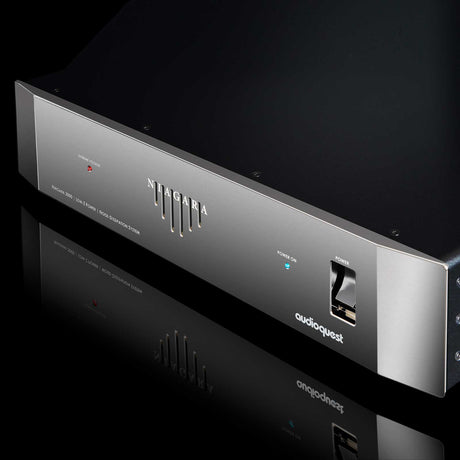
On Bi-Wiring and Power Conditioning
AudioQuest's Niagara 3000 proves to be a first of its kind — the first power conditioner Alex Halberstadt doesn't hate, that is.
Câble d'alimentation
Souvent, le choix entre terminer vos câbles d'enceinte avec des fourches ou des fiches bananes dépendra de la préférence personnelle. Cependant, les bornes de liaison isolées conformes à l'UE utilisées sur certains amplificateurs de puissance rendent souvent difficile, voire impossible, de serrer les fourches avec un couple ou une pression élevés. Dans ces applications, le connecteur banane AudioQuest est le meilleur choix, et peut être le seul.
AudioQuest a mené une enquête assez exhaustive auprès des fabricants d'amplificateurs contemporains pour déterminer si les fourches ou les bananes seront les plus appropriées pour une marque et un modèle d'amplificateur donnés. Veuillez nous contacter, fournir la marque et le modèle de l'amplificateur, et nous vous répondrons quel type de connecteur est optimal.
Ici, nous recommandons généralement le connecteur U-Spade ou banane. Cependant, même s'il y a moins de poids et de pression de ce côté du câble (particulièrement pour les ensembles Bi-Câblage), il est néanmoins important de noter la conception du bornier. Si un connecteur banane ne peut pas s'insérer complètement dans la bornier, nous recommandons l'un de nos connecteurs à fourche.
Câbles à courant constant (source)
Optimisés pour une utilisation avec des composants sources audio/vidéo, qui ont une consommation de courant constante ou « fixe ».
Conducteurs en argent à surface parfaite solide (PSS)
Les conducteurs solides empêchent l'interaction électrique et magnétique des brins. Le PSS en argent massif minimise la distorsion causée par les frontières des grains et maximise la dissipation du bruit RF linéaire.
ZERO-Tech
Alors que de nombreux câbles d'alimentation CA présentent une faible résistance CC pour répondre à la demande de courant élevé, l'impédance caractéristique d'un câble est également cruciale pour des performances optimales. Contrairement à la plupart des câbles CA qui restreignent ou compressent un transitoire audio-provoqué, les câbles CA AudioQuest combinent une faible résistance CC et ZERO (aucune) impédance caractéristique afin de délivrer des transitoires à haute intensité non compressés à la demande.
RF/ND-Tech
Les fils de terre CA peuvent fournir une protection contre un court-circuit électrique, mais ils agissent également comme une antenne. Ainsi, ils sont sujets au bruit radiofréquence (RF) induit. Ce bruit RF contourne les alimentations des composants et est généralement couplé directement aux circuits audio/vidéo les plus sensibles d'un système. La RF/ND-Tech de AudioQuest réduit considérablement cette distorsion, offrant des niveaux sans précédent de dissipation du bruit sur la plus large bande passante (gamme) de fréquences radio possible. Notre topologie de circuit unique utilise un réseau de phase annulant le mode commun, en concert avec des matériaux diélectriques propriétaires qui fournissent un filtrage différentiel linéaire supplémentaire. Brevet américain # 8,988,168.
Directionnalité
Tous les brins ou conducteurs de métal étirés ont une structure de grain non symétrique, et donc directionnelle. AudioQuest contrôle la variation d'impédance RF résultante afin que le bruit soit évacué de l'endroit où il causerait une distorsion. La direction correcte est déterminée en écoutant chaque lot de conducteurs métalliques utilisés dans chaque câble audio AudioQuest. Le cas échéant, des flèches sont clairement marquées sur les connecteurs pour garantir une qualité sonore supérieure. Pour la plupart des modèles de câbles AQ, les flèches indiquent non seulement la direction qui optimise la directionnalité du métal dans le cadre de la dissipation du bruit, mais indiquent également l'attachement non symétrique de l'écran et du GND afin d'optimiser les performances du système complet.